ENER20002 Mine Report: Risk Assessment and Geological Overview
VerifiedAdded on 2023/01/20
|18
|4873
|31
Report
AI Summary
This report, prepared by a student, presents a comprehensive analysis of a visit to the Fosterville Gold Mine. It begins with a risk assessment, identifying the most dangerous activities and major hazards, and proposes control measures. The report then delves into the regional geology of the Bendigo Structural Zone within the Lachlan Fold Belt, detailing the history of geological discoveries and the evolution of the Fosterville deposits. It explores prospecting and exploration phases, including significant exploration programs and the regional stratigraphic column. The report also examines the style, age, and genesis of gold mineralization, differentiating between visible and sulfide gold. Furthermore, it identifies areas of future exploration potential and discusses the environmental measures and controls implemented by the mining companies, including water management and noise mitigation. Finally, it outlines the regulatory framework governing the Fosterville Gold Mine's operations.
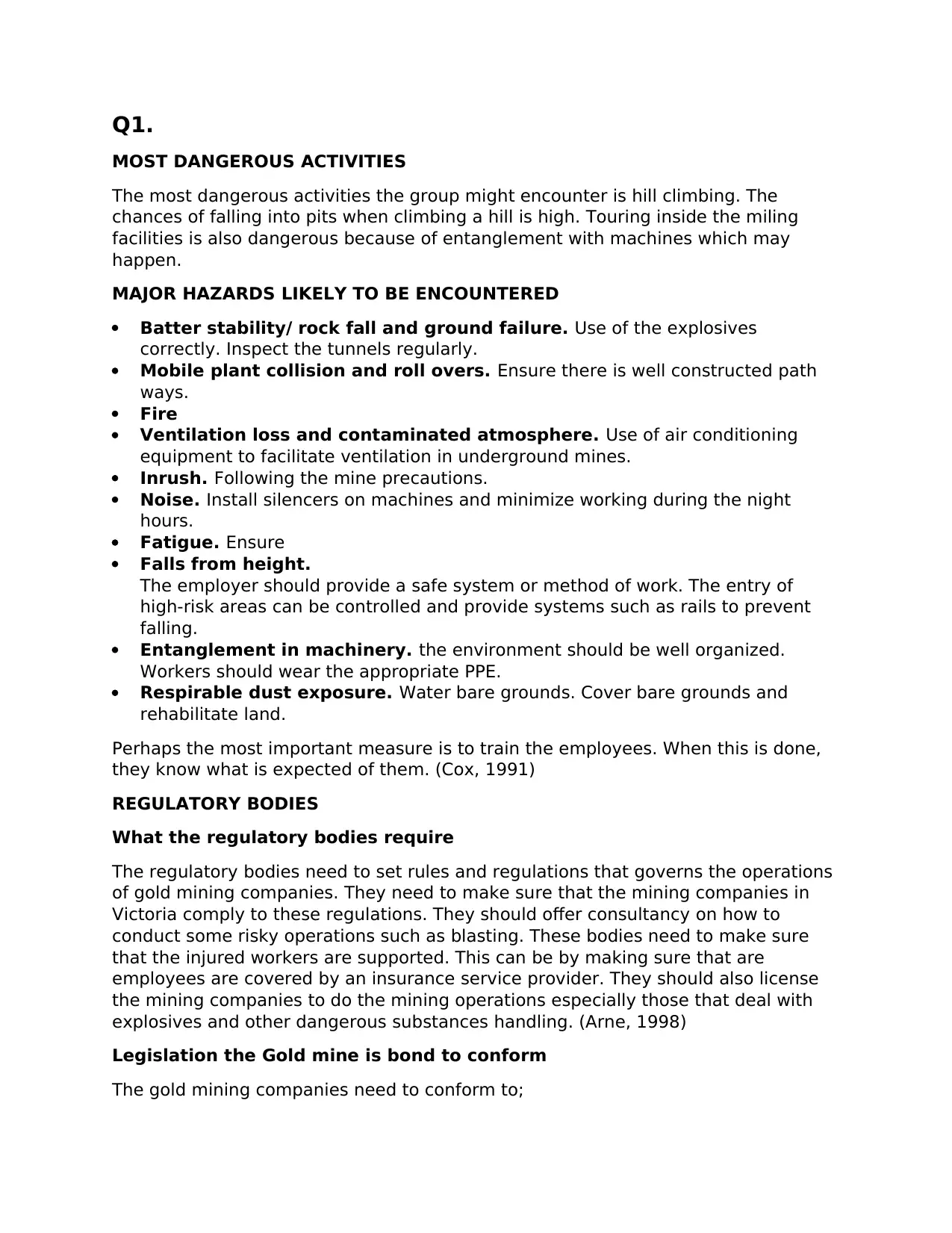
Q1.
MOST DANGEROUS ACTIVITIES
The most dangerous activities the group might encounter is hill climbing. The
chances of falling into pits when climbing a hill is high. Touring inside the miling
facilities is also dangerous because of entanglement with machines which may
happen.
MAJOR HAZARDS LIKELY TO BE ENCOUNTERED
Batter stability/ rock fall and ground failure. Use of the explosives
correctly. Inspect the tunnels regularly.
Mobile plant collision and roll overs. Ensure there is well constructed path
ways.
Fire
Ventilation loss and contaminated atmosphere. Use of air conditioning
equipment to facilitate ventilation in underground mines.
Inrush. Following the mine precautions.
Noise. Install silencers on machines and minimize working during the night
hours.
Fatigue. Ensure
Falls from height.
The employer should provide a safe system or method of work. The entry of
high-risk areas can be controlled and provide systems such as rails to prevent
falling.
Entanglement in machinery. the environment should be well organized.
Workers should wear the appropriate PPE.
Respirable dust exposure. Water bare grounds. Cover bare grounds and
rehabilitate land.
Perhaps the most important measure is to train the employees. When this is done,
they know what is expected of them. (Cox, 1991)
REGULATORY BODIES
What the regulatory bodies require
The regulatory bodies need to set rules and regulations that governs the operations
of gold mining companies. They need to make sure that the mining companies in
Victoria comply to these regulations. They should offer consultancy on how to
conduct some risky operations such as blasting. These bodies need to make sure
that the injured workers are supported. This can be by making sure that are
employees are covered by an insurance service provider. They should also license
the mining companies to do the mining operations especially those that deal with
explosives and other dangerous substances handling. (Arne, 1998)
Legislation the Gold mine is bond to conform
The gold mining companies need to conform to;
MOST DANGEROUS ACTIVITIES
The most dangerous activities the group might encounter is hill climbing. The
chances of falling into pits when climbing a hill is high. Touring inside the miling
facilities is also dangerous because of entanglement with machines which may
happen.
MAJOR HAZARDS LIKELY TO BE ENCOUNTERED
Batter stability/ rock fall and ground failure. Use of the explosives
correctly. Inspect the tunnels regularly.
Mobile plant collision and roll overs. Ensure there is well constructed path
ways.
Fire
Ventilation loss and contaminated atmosphere. Use of air conditioning
equipment to facilitate ventilation in underground mines.
Inrush. Following the mine precautions.
Noise. Install silencers on machines and minimize working during the night
hours.
Fatigue. Ensure
Falls from height.
The employer should provide a safe system or method of work. The entry of
high-risk areas can be controlled and provide systems such as rails to prevent
falling.
Entanglement in machinery. the environment should be well organized.
Workers should wear the appropriate PPE.
Respirable dust exposure. Water bare grounds. Cover bare grounds and
rehabilitate land.
Perhaps the most important measure is to train the employees. When this is done,
they know what is expected of them. (Cox, 1991)
REGULATORY BODIES
What the regulatory bodies require
The regulatory bodies need to set rules and regulations that governs the operations
of gold mining companies. They need to make sure that the mining companies in
Victoria comply to these regulations. They should offer consultancy on how to
conduct some risky operations such as blasting. These bodies need to make sure
that the injured workers are supported. This can be by making sure that are
employees are covered by an insurance service provider. They should also license
the mining companies to do the mining operations especially those that deal with
explosives and other dangerous substances handling. (Arne, 1998)
Legislation the Gold mine is bond to conform
The gold mining companies need to conform to;
Paraphrase This Document
Need a fresh take? Get an instant paraphrase of this document with our AI Paraphraser
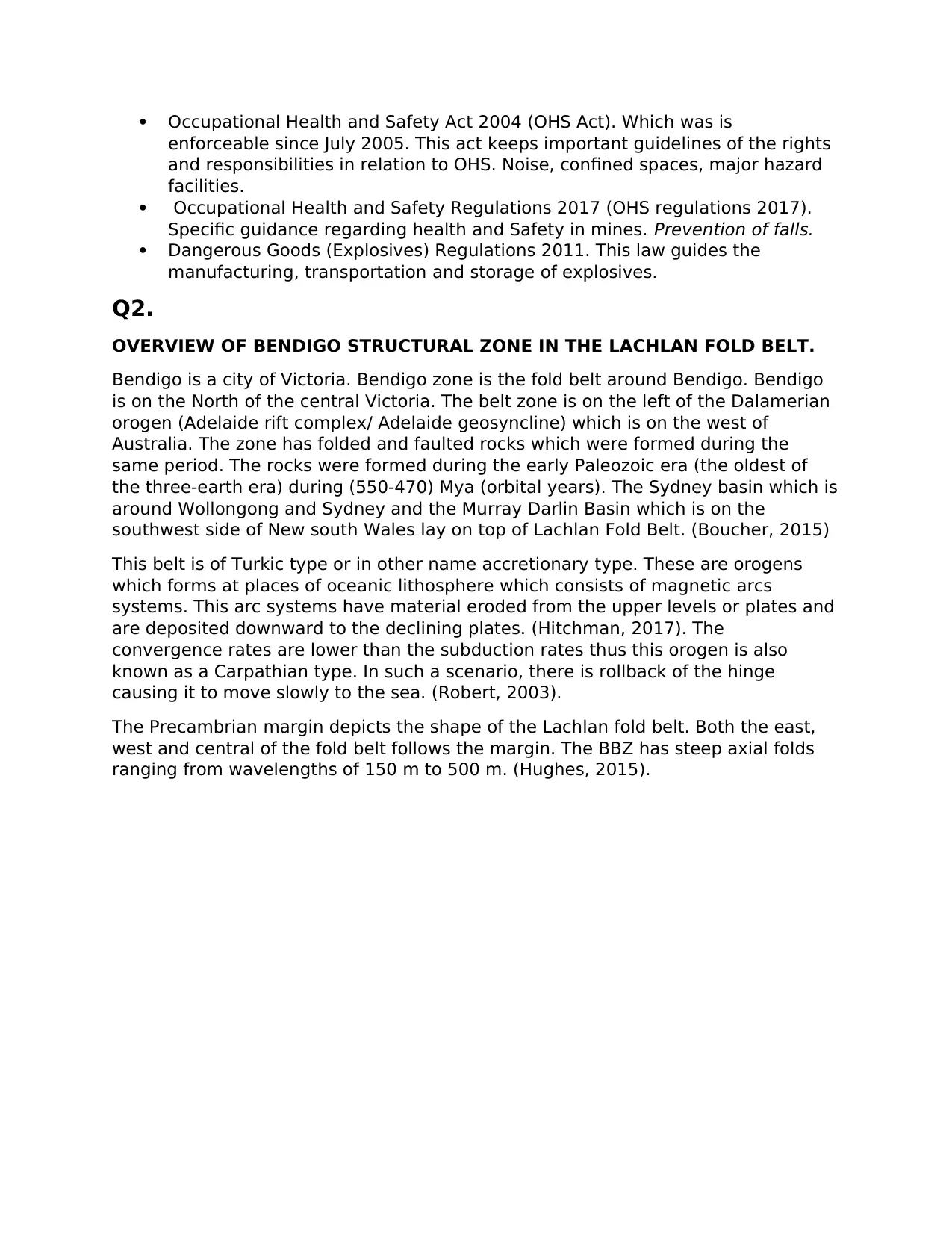
Occupational Health and Safety Act 2004 (OHS Act). Which was is
enforceable since July 2005. This act keeps important guidelines of the rights
and responsibilities in relation to OHS. Noise, confined spaces, major hazard
facilities.
Occupational Health and Safety Regulations 2017 (OHS regulations 2017).
Specific guidance regarding health and Safety in mines. Prevention of falls.
Dangerous Goods (Explosives) Regulations 2011. This law guides the
manufacturing, transportation and storage of explosives.
Q2.
OVERVIEW OF BENDIGO STRUCTURAL ZONE IN THE LACHLAN FOLD BELT.
Bendigo is a city of Victoria. Bendigo zone is the fold belt around Bendigo. Bendigo
is on the North of the central Victoria. The belt zone is on the left of the Dalamerian
orogen (Adelaide rift complex/ Adelaide geosyncline) which is on the west of
Australia. The zone has folded and faulted rocks which were formed during the
same period. The rocks were formed during the early Paleozoic era (the oldest of
the three-earth era) during (550-470) Mya (orbital years). The Sydney basin which is
around Wollongong and Sydney and the Murray Darlin Basin which is on the
southwest side of New south Wales lay on top of Lachlan Fold Belt. (Boucher, 2015)
This belt is of Turkic type or in other name accretionary type. These are orogens
which forms at places of oceanic lithosphere which consists of magnetic arcs
systems. This arc systems have material eroded from the upper levels or plates and
are deposited downward to the declining plates. (Hitchman, 2017). The
convergence rates are lower than the subduction rates thus this orogen is also
known as a Carpathian type. In such a scenario, there is rollback of the hinge
causing it to move slowly to the sea. (Robert, 2003).
The Precambrian margin depicts the shape of the Lachlan fold belt. Both the east,
west and central of the fold belt follows the margin. The BBZ has steep axial folds
ranging from wavelengths of 150 m to 500 m. (Hughes, 2015).
enforceable since July 2005. This act keeps important guidelines of the rights
and responsibilities in relation to OHS. Noise, confined spaces, major hazard
facilities.
Occupational Health and Safety Regulations 2017 (OHS regulations 2017).
Specific guidance regarding health and Safety in mines. Prevention of falls.
Dangerous Goods (Explosives) Regulations 2011. This law guides the
manufacturing, transportation and storage of explosives.
Q2.
OVERVIEW OF BENDIGO STRUCTURAL ZONE IN THE LACHLAN FOLD BELT.
Bendigo is a city of Victoria. Bendigo zone is the fold belt around Bendigo. Bendigo
is on the North of the central Victoria. The belt zone is on the left of the Dalamerian
orogen (Adelaide rift complex/ Adelaide geosyncline) which is on the west of
Australia. The zone has folded and faulted rocks which were formed during the
same period. The rocks were formed during the early Paleozoic era (the oldest of
the three-earth era) during (550-470) Mya (orbital years). The Sydney basin which is
around Wollongong and Sydney and the Murray Darlin Basin which is on the
southwest side of New south Wales lay on top of Lachlan Fold Belt. (Boucher, 2015)
This belt is of Turkic type or in other name accretionary type. These are orogens
which forms at places of oceanic lithosphere which consists of magnetic arcs
systems. This arc systems have material eroded from the upper levels or plates and
are deposited downward to the declining plates. (Hitchman, 2017). The
convergence rates are lower than the subduction rates thus this orogen is also
known as a Carpathian type. In such a scenario, there is rollback of the hinge
causing it to move slowly to the sea. (Robert, 2003).
The Precambrian margin depicts the shape of the Lachlan fold belt. Both the east,
west and central of the fold belt follows the margin. The BBZ has steep axial folds
ranging from wavelengths of 150 m to 500 m. (Hughes, 2015).
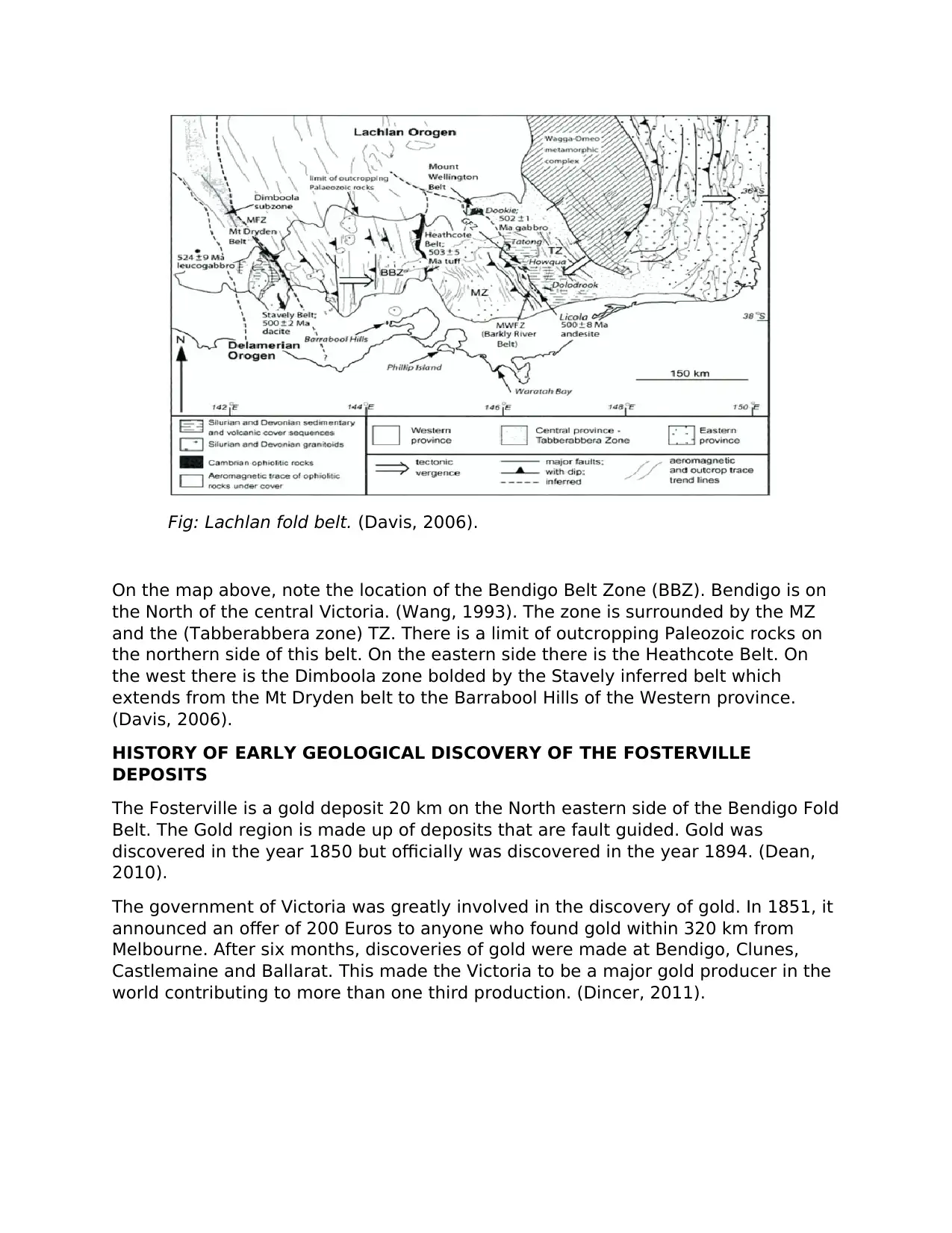
Fig: Lachlan fold belt. (Davis, 2006).
On the map above, note the location of the Bendigo Belt Zone (BBZ). Bendigo is on
the North of the central Victoria. (Wang, 1993). The zone is surrounded by the MZ
and the (Tabberabbera zone) TZ. There is a limit of outcropping Paleozoic rocks on
the northern side of this belt. On the eastern side there is the Heathcote Belt. On
the west there is the Dimboola zone bolded by the Stavely inferred belt which
extends from the Mt Dryden belt to the Barrabool Hills of the Western province.
(Davis, 2006).
HISTORY OF EARLY GEOLOGICAL DISCOVERY OF THE FOSTERVILLE
DEPOSITS
The Fosterville is a gold deposit 20 km on the North eastern side of the Bendigo Fold
Belt. The Gold region is made up of deposits that are fault guided. Gold was
discovered in the year 1850 but officially was discovered in the year 1894. (Dean,
2010).
The government of Victoria was greatly involved in the discovery of gold. In 1851, it
announced an offer of 200 Euros to anyone who found gold within 320 km from
Melbourne. After six months, discoveries of gold were made at Bendigo, Clunes,
Castlemaine and Ballarat. This made the Victoria to be a major gold producer in the
world contributing to more than one third production. (Dincer, 2011).
On the map above, note the location of the Bendigo Belt Zone (BBZ). Bendigo is on
the North of the central Victoria. (Wang, 1993). The zone is surrounded by the MZ
and the (Tabberabbera zone) TZ. There is a limit of outcropping Paleozoic rocks on
the northern side of this belt. On the eastern side there is the Heathcote Belt. On
the west there is the Dimboola zone bolded by the Stavely inferred belt which
extends from the Mt Dryden belt to the Barrabool Hills of the Western province.
(Davis, 2006).
HISTORY OF EARLY GEOLOGICAL DISCOVERY OF THE FOSTERVILLE
DEPOSITS
The Fosterville is a gold deposit 20 km on the North eastern side of the Bendigo Fold
Belt. The Gold region is made up of deposits that are fault guided. Gold was
discovered in the year 1850 but officially was discovered in the year 1894. (Dean,
2010).
The government of Victoria was greatly involved in the discovery of gold. In 1851, it
announced an offer of 200 Euros to anyone who found gold within 320 km from
Melbourne. After six months, discoveries of gold were made at Bendigo, Clunes,
Castlemaine and Ballarat. This made the Victoria to be a major gold producer in the
world contributing to more than one third production. (Dincer, 2011).
⊘ This is a preview!⊘
Do you want full access?
Subscribe today to unlock all pages.

Trusted by 1+ million students worldwide
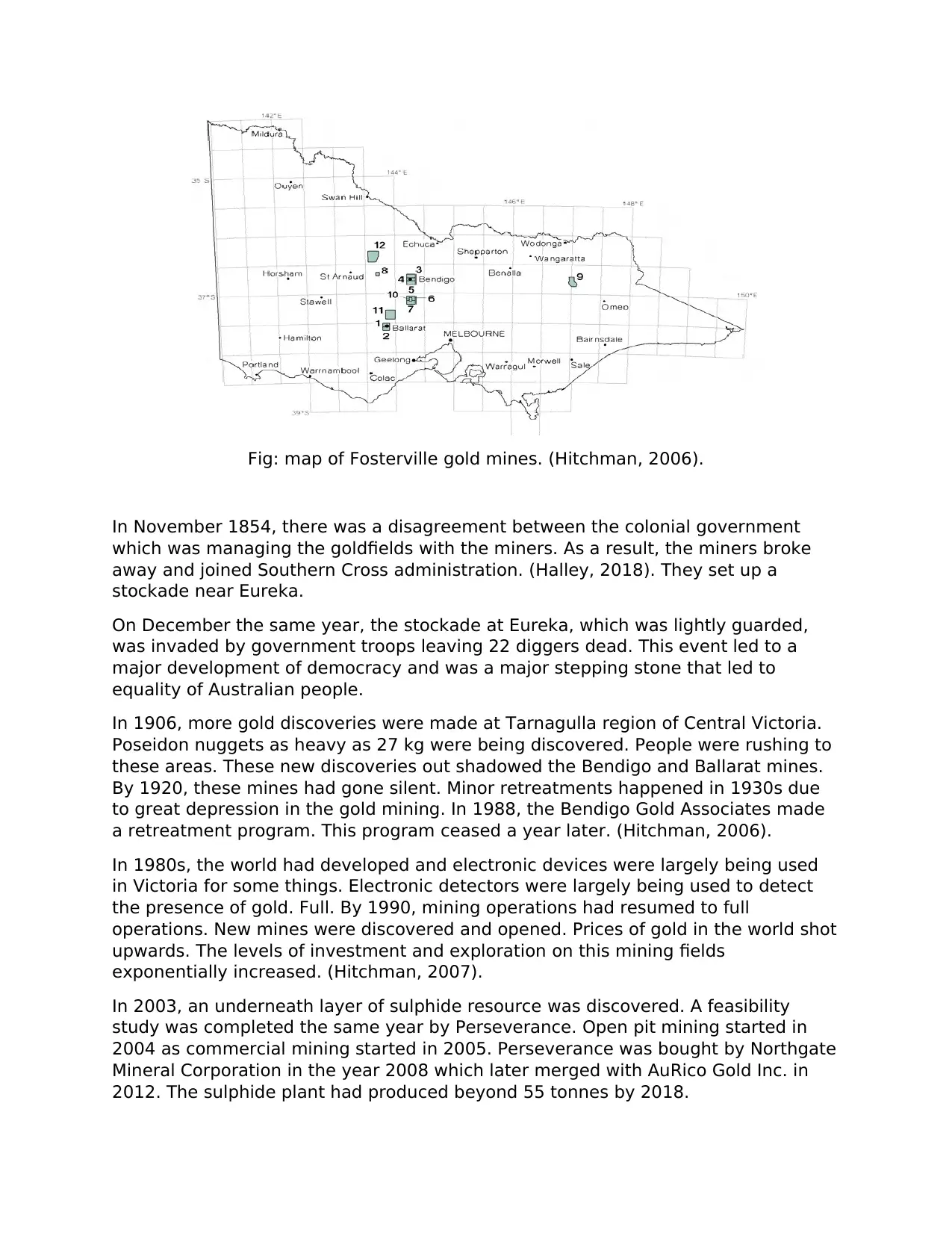
Fig: map of Fosterville gold mines. (Hitchman, 2006).
In November 1854, there was a disagreement between the colonial government
which was managing the goldfields with the miners. As a result, the miners broke
away and joined Southern Cross administration. (Halley, 2018). They set up a
stockade near Eureka.
On December the same year, the stockade at Eureka, which was lightly guarded,
was invaded by government troops leaving 22 diggers dead. This event led to a
major development of democracy and was a major stepping stone that led to
equality of Australian people.
In 1906, more gold discoveries were made at Tarnagulla region of Central Victoria.
Poseidon nuggets as heavy as 27 kg were being discovered. People were rushing to
these areas. These new discoveries out shadowed the Bendigo and Ballarat mines.
By 1920, these mines had gone silent. Minor retreatments happened in 1930s due
to great depression in the gold mining. In 1988, the Bendigo Gold Associates made
a retreatment program. This program ceased a year later. (Hitchman, 2006).
In 1980s, the world had developed and electronic devices were largely being used
in Victoria for some things. Electronic detectors were largely being used to detect
the presence of gold. Full. By 1990, mining operations had resumed to full
operations. New mines were discovered and opened. Prices of gold in the world shot
upwards. The levels of investment and exploration on this mining fields
exponentially increased. (Hitchman, 2007).
In 2003, an underneath layer of sulphide resource was discovered. A feasibility
study was completed the same year by Perseverance. Open pit mining started in
2004 as commercial mining started in 2005. Perseverance was bought by Northgate
Mineral Corporation in the year 2008 which later merged with AuRico Gold Inc. in
2012. The sulphide plant had produced beyond 55 tonnes by 2018.
In November 1854, there was a disagreement between the colonial government
which was managing the goldfields with the miners. As a result, the miners broke
away and joined Southern Cross administration. (Halley, 2018). They set up a
stockade near Eureka.
On December the same year, the stockade at Eureka, which was lightly guarded,
was invaded by government troops leaving 22 diggers dead. This event led to a
major development of democracy and was a major stepping stone that led to
equality of Australian people.
In 1906, more gold discoveries were made at Tarnagulla region of Central Victoria.
Poseidon nuggets as heavy as 27 kg were being discovered. People were rushing to
these areas. These new discoveries out shadowed the Bendigo and Ballarat mines.
By 1920, these mines had gone silent. Minor retreatments happened in 1930s due
to great depression in the gold mining. In 1988, the Bendigo Gold Associates made
a retreatment program. This program ceased a year later. (Hitchman, 2006).
In 1980s, the world had developed and electronic devices were largely being used
in Victoria for some things. Electronic detectors were largely being used to detect
the presence of gold. Full. By 1990, mining operations had resumed to full
operations. New mines were discovered and opened. Prices of gold in the world shot
upwards. The levels of investment and exploration on this mining fields
exponentially increased. (Hitchman, 2007).
In 2003, an underneath layer of sulphide resource was discovered. A feasibility
study was completed the same year by Perseverance. Open pit mining started in
2004 as commercial mining started in 2005. Perseverance was bought by Northgate
Mineral Corporation in the year 2008 which later merged with AuRico Gold Inc. in
2012. The sulphide plant had produced beyond 55 tonnes by 2018.
Paraphrase This Document
Need a fresh take? Get an instant paraphrase of this document with our AI Paraphraser
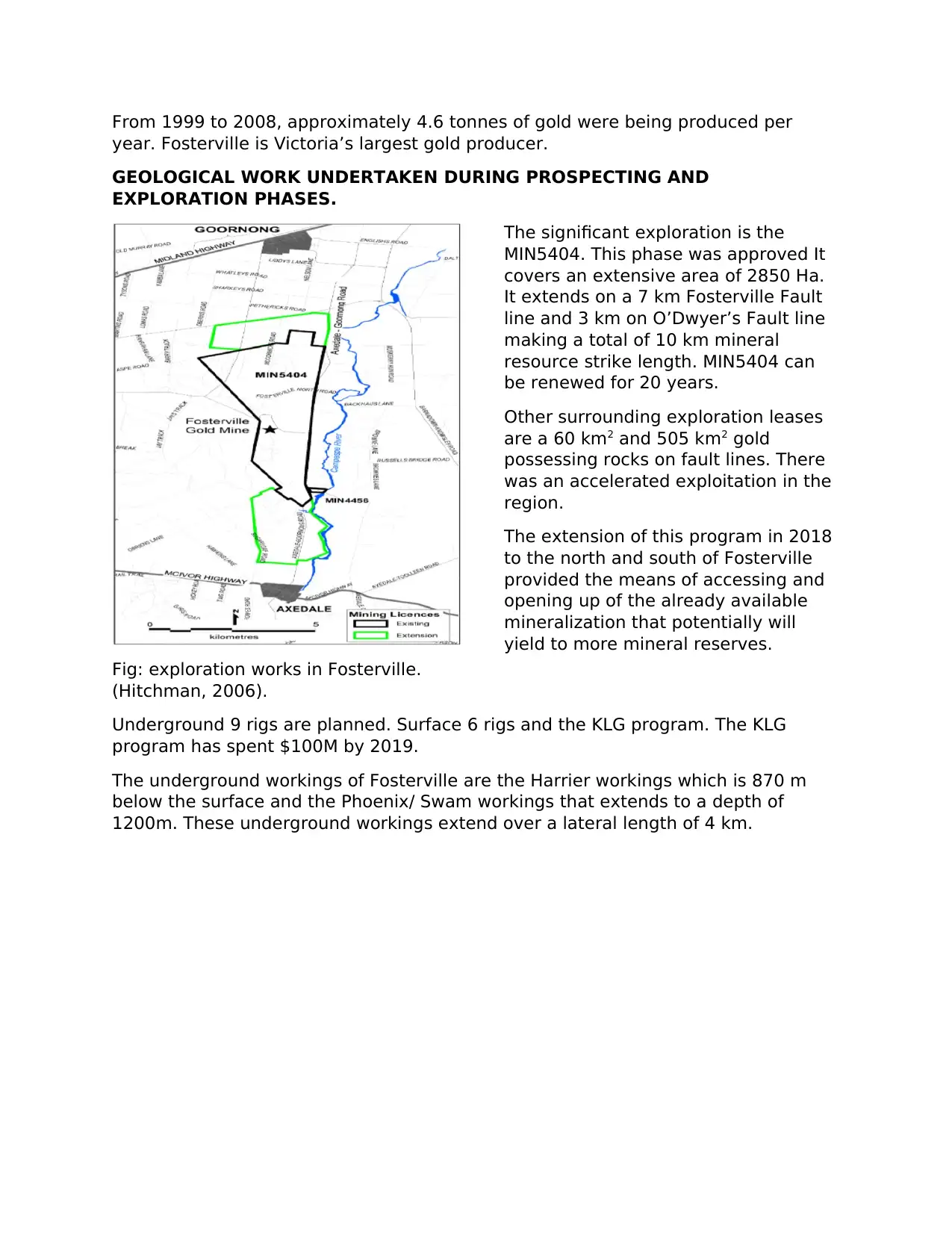
From 1999 to 2008, approximately 4.6 tonnes of gold were being produced per
year. Fosterville is Victoria’s largest gold producer.
GEOLOGICAL WORK UNDERTAKEN DURING PROSPECTING AND
EXPLORATION PHASES.
Fig: exploration works in Fosterville.
(Hitchman, 2006).
The significant exploration is the
MIN5404. This phase was approved It
covers an extensive area of 2850 Ha.
It extends on a 7 km Fosterville Fault
line and 3 km on O’Dwyer’s Fault line
making a total of 10 km mineral
resource strike length. MIN5404 can
be renewed for 20 years.
Other surrounding exploration leases
are a 60 km2 and 505 km2 gold
possessing rocks on fault lines. There
was an accelerated exploitation in the
region.
The extension of this program in 2018
to the north and south of Fosterville
provided the means of accessing and
opening up of the already available
mineralization that potentially will
yield to more mineral reserves.
Underground 9 rigs are planned. Surface 6 rigs and the KLG program. The KLG
program has spent $100M by 2019.
The underground workings of Fosterville are the Harrier workings which is 870 m
below the surface and the Phoenix/ Swam workings that extends to a depth of
1200m. These underground workings extend over a lateral length of 4 km.
year. Fosterville is Victoria’s largest gold producer.
GEOLOGICAL WORK UNDERTAKEN DURING PROSPECTING AND
EXPLORATION PHASES.
Fig: exploration works in Fosterville.
(Hitchman, 2006).
The significant exploration is the
MIN5404. This phase was approved It
covers an extensive area of 2850 Ha.
It extends on a 7 km Fosterville Fault
line and 3 km on O’Dwyer’s Fault line
making a total of 10 km mineral
resource strike length. MIN5404 can
be renewed for 20 years.
Other surrounding exploration leases
are a 60 km2 and 505 km2 gold
possessing rocks on fault lines. There
was an accelerated exploitation in the
region.
The extension of this program in 2018
to the north and south of Fosterville
provided the means of accessing and
opening up of the already available
mineralization that potentially will
yield to more mineral reserves.
Underground 9 rigs are planned. Surface 6 rigs and the KLG program. The KLG
program has spent $100M by 2019.
The underground workings of Fosterville are the Harrier workings which is 870 m
below the surface and the Phoenix/ Swam workings that extends to a depth of
1200m. These underground workings extend over a lateral length of 4 km.
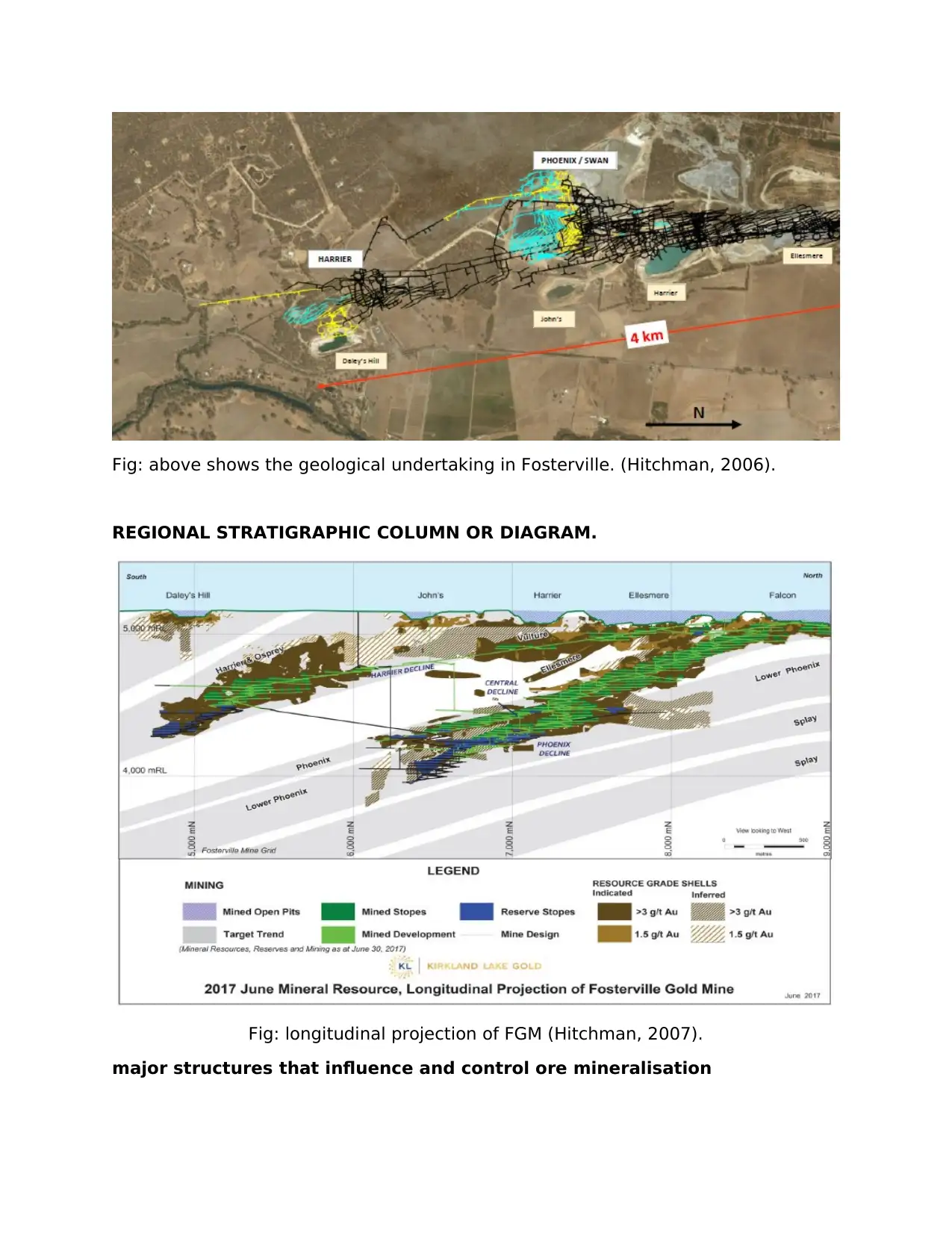
Fig: above shows the geological undertaking in Fosterville. (Hitchman, 2006).
REGIONAL STRATIGRAPHIC COLUMN OR DIAGRAM.
Fig: longitudinal projection of FGM (Hitchman, 2007).
major structures that influence and control ore mineralisation
REGIONAL STRATIGRAPHIC COLUMN OR DIAGRAM.
Fig: longitudinal projection of FGM (Hitchman, 2007).
major structures that influence and control ore mineralisation
⊘ This is a preview!⊘
Do you want full access?
Subscribe today to unlock all pages.

Trusted by 1+ million students worldwide
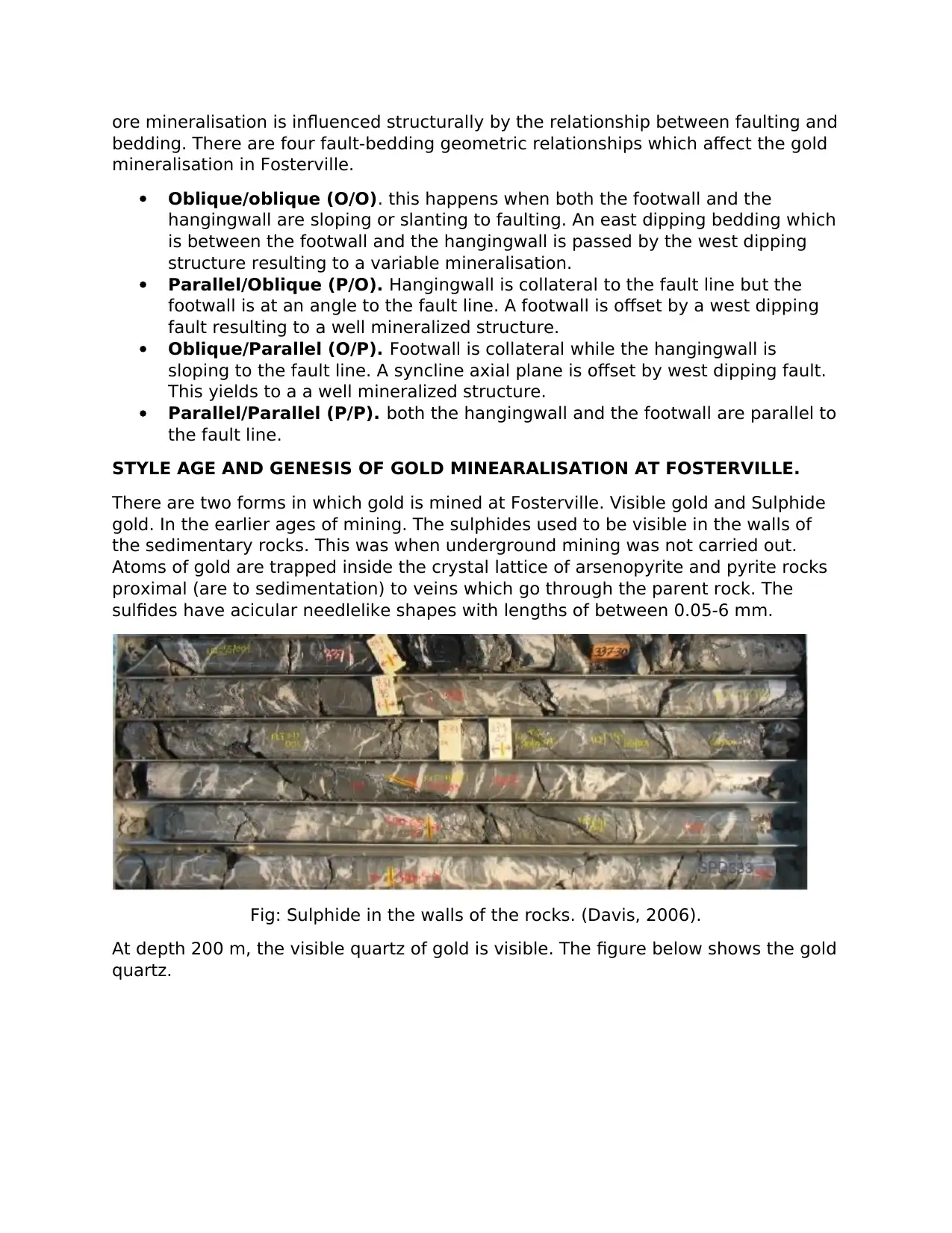
ore mineralisation is influenced structurally by the relationship between faulting and
bedding. There are four fault-bedding geometric relationships which affect the gold
mineralisation in Fosterville.
Oblique/oblique (O/O). this happens when both the footwall and the
hangingwall are sloping or slanting to faulting. An east dipping bedding which
is between the footwall and the hangingwall is passed by the west dipping
structure resulting to a variable mineralisation.
Parallel/Oblique (P/O). Hangingwall is collateral to the fault line but the
footwall is at an angle to the fault line. A footwall is offset by a west dipping
fault resulting to a well mineralized structure.
Oblique/Parallel (O/P). Footwall is collateral while the hangingwall is
sloping to the fault line. A syncline axial plane is offset by west dipping fault.
This yields to a a well mineralized structure.
Parallel/Parallel (P/P). both the hangingwall and the footwall are parallel to
the fault line.
STYLE AGE AND GENESIS OF GOLD MINEARALISATION AT FOSTERVILLE.
There are two forms in which gold is mined at Fosterville. Visible gold and Sulphide
gold. In the earlier ages of mining. The sulphides used to be visible in the walls of
the sedimentary rocks. This was when underground mining was not carried out.
Atoms of gold are trapped inside the crystal lattice of arsenopyrite and pyrite rocks
proximal (are to sedimentation) to veins which go through the parent rock. The
sulfides have acicular needlelike shapes with lengths of between 0.05-6 mm.
Fig: Sulphide in the walls of the rocks. (Davis, 2006).
At depth 200 m, the visible quartz of gold is visible. The figure below shows the gold
quartz.
bedding. There are four fault-bedding geometric relationships which affect the gold
mineralisation in Fosterville.
Oblique/oblique (O/O). this happens when both the footwall and the
hangingwall are sloping or slanting to faulting. An east dipping bedding which
is between the footwall and the hangingwall is passed by the west dipping
structure resulting to a variable mineralisation.
Parallel/Oblique (P/O). Hangingwall is collateral to the fault line but the
footwall is at an angle to the fault line. A footwall is offset by a west dipping
fault resulting to a well mineralized structure.
Oblique/Parallel (O/P). Footwall is collateral while the hangingwall is
sloping to the fault line. A syncline axial plane is offset by west dipping fault.
This yields to a a well mineralized structure.
Parallel/Parallel (P/P). both the hangingwall and the footwall are parallel to
the fault line.
STYLE AGE AND GENESIS OF GOLD MINEARALISATION AT FOSTERVILLE.
There are two forms in which gold is mined at Fosterville. Visible gold and Sulphide
gold. In the earlier ages of mining. The sulphides used to be visible in the walls of
the sedimentary rocks. This was when underground mining was not carried out.
Atoms of gold are trapped inside the crystal lattice of arsenopyrite and pyrite rocks
proximal (are to sedimentation) to veins which go through the parent rock. The
sulfides have acicular needlelike shapes with lengths of between 0.05-6 mm.
Fig: Sulphide in the walls of the rocks. (Davis, 2006).
At depth 200 m, the visible quartz of gold is visible. The figure below shows the gold
quartz.
Paraphrase This Document
Need a fresh take? Get an instant paraphrase of this document with our AI Paraphraser
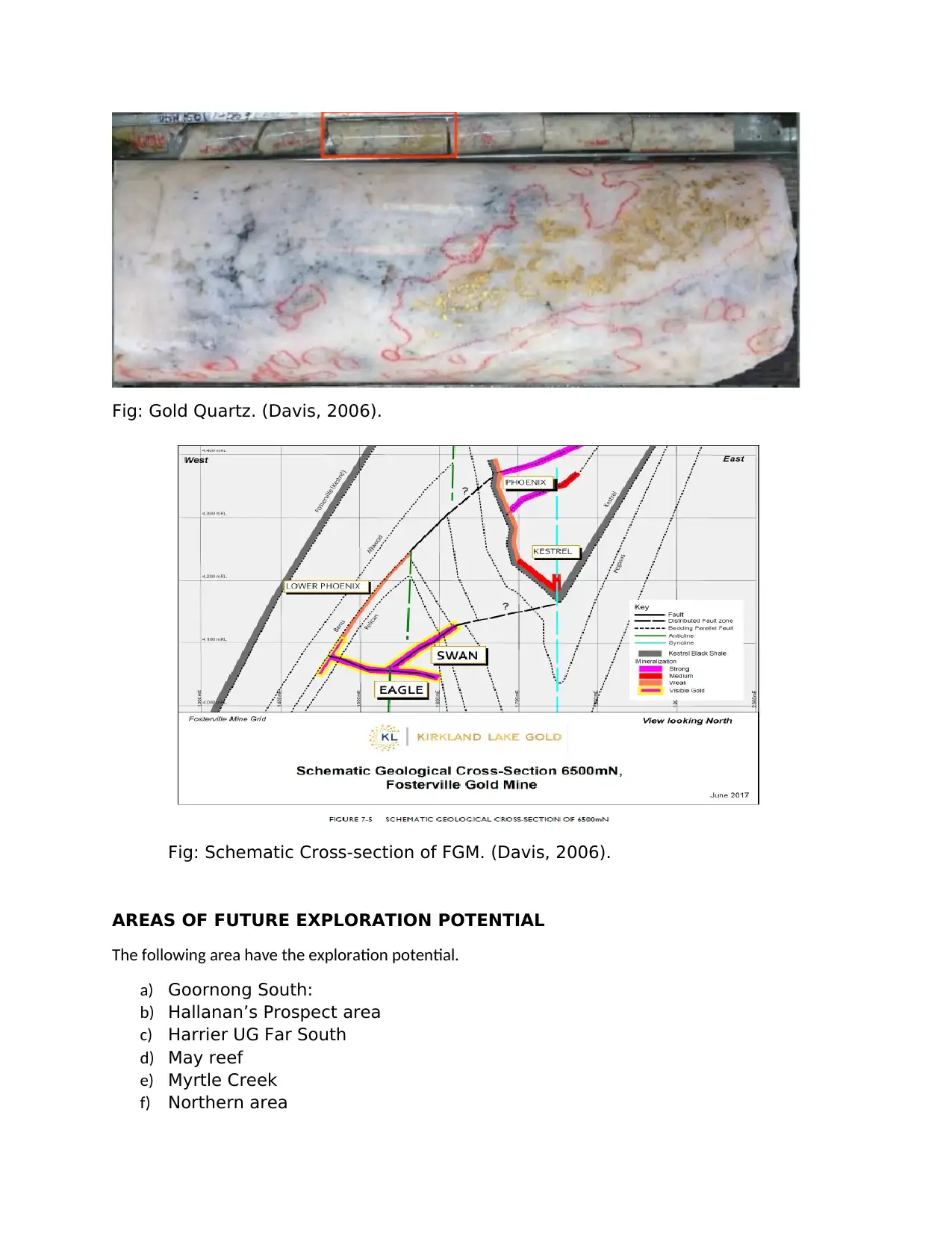
Fig: Gold Quartz. (Davis, 2006).
Fig: Schematic Cross-section of FGM. (Davis, 2006).
AREAS OF FUTURE EXPLORATION POTENTIAL
The following area have the exploration potential.
a) Goornong South:
b) Hallanan’s Prospect area
c) Harrier UG Far South
d) May reef
e) Myrtle Creek
f) Northern area
Fig: Schematic Cross-section of FGM. (Davis, 2006).
AREAS OF FUTURE EXPLORATION POTENTIAL
The following area have the exploration potential.
a) Goornong South:
b) Hallanan’s Prospect area
c) Harrier UG Far South
d) May reef
e) Myrtle Creek
f) Northern area
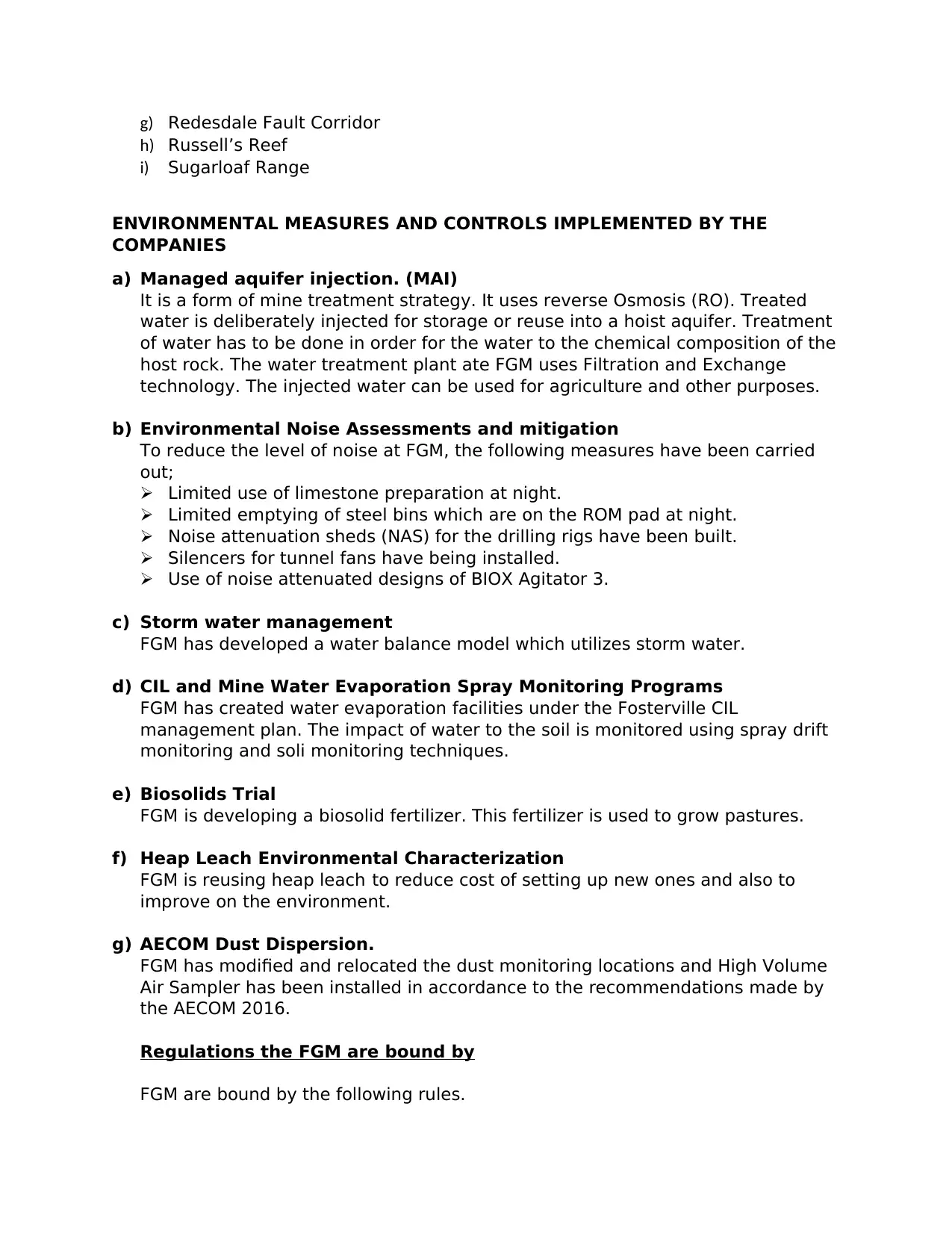
g) Redesdale Fault Corridor
h) Russell’s Reef
i) Sugarloaf Range
ENVIRONMENTAL MEASURES AND CONTROLS IMPLEMENTED BY THE
COMPANIES
a) Managed aquifer injection. (MAI)
It is a form of mine treatment strategy. It uses reverse Osmosis (RO). Treated
water is deliberately injected for storage or reuse into a hoist aquifer. Treatment
of water has to be done in order for the water to the chemical composition of the
host rock. The water treatment plant ate FGM uses Filtration and Exchange
technology. The injected water can be used for agriculture and other purposes.
b) Environmental Noise Assessments and mitigation
To reduce the level of noise at FGM, the following measures have been carried
out;
Limited use of limestone preparation at night.
Limited emptying of steel bins which are on the ROM pad at night.
Noise attenuation sheds (NAS) for the drilling rigs have been built.
Silencers for tunnel fans have being installed.
Use of noise attenuated designs of BIOX Agitator 3.
c) Storm water management
FGM has developed a water balance model which utilizes storm water.
d) CIL and Mine Water Evaporation Spray Monitoring Programs
FGM has created water evaporation facilities under the Fosterville CIL
management plan. The impact of water to the soil is monitored using spray drift
monitoring and soli monitoring techniques.
e) Biosolids Trial
FGM is developing a biosolid fertilizer. This fertilizer is used to grow pastures.
f) Heap Leach Environmental Characterization
FGM is reusing heap leach to reduce cost of setting up new ones and also to
improve on the environment.
g) AECOM Dust Dispersion.
FGM has modified and relocated the dust monitoring locations and High Volume
Air Sampler has been installed in accordance to the recommendations made by
the AECOM 2016.
Regulations the FGM are bound by
FGM are bound by the following rules.
h) Russell’s Reef
i) Sugarloaf Range
ENVIRONMENTAL MEASURES AND CONTROLS IMPLEMENTED BY THE
COMPANIES
a) Managed aquifer injection. (MAI)
It is a form of mine treatment strategy. It uses reverse Osmosis (RO). Treated
water is deliberately injected for storage or reuse into a hoist aquifer. Treatment
of water has to be done in order for the water to the chemical composition of the
host rock. The water treatment plant ate FGM uses Filtration and Exchange
technology. The injected water can be used for agriculture and other purposes.
b) Environmental Noise Assessments and mitigation
To reduce the level of noise at FGM, the following measures have been carried
out;
Limited use of limestone preparation at night.
Limited emptying of steel bins which are on the ROM pad at night.
Noise attenuation sheds (NAS) for the drilling rigs have been built.
Silencers for tunnel fans have being installed.
Use of noise attenuated designs of BIOX Agitator 3.
c) Storm water management
FGM has developed a water balance model which utilizes storm water.
d) CIL and Mine Water Evaporation Spray Monitoring Programs
FGM has created water evaporation facilities under the Fosterville CIL
management plan. The impact of water to the soil is monitored using spray drift
monitoring and soli monitoring techniques.
e) Biosolids Trial
FGM is developing a biosolid fertilizer. This fertilizer is used to grow pastures.
f) Heap Leach Environmental Characterization
FGM is reusing heap leach to reduce cost of setting up new ones and also to
improve on the environment.
g) AECOM Dust Dispersion.
FGM has modified and relocated the dust monitoring locations and High Volume
Air Sampler has been installed in accordance to the recommendations made by
the AECOM 2016.
Regulations the FGM are bound by
FGM are bound by the following rules.
⊘ This is a preview!⊘
Do you want full access?
Subscribe today to unlock all pages.

Trusted by 1+ million students worldwide
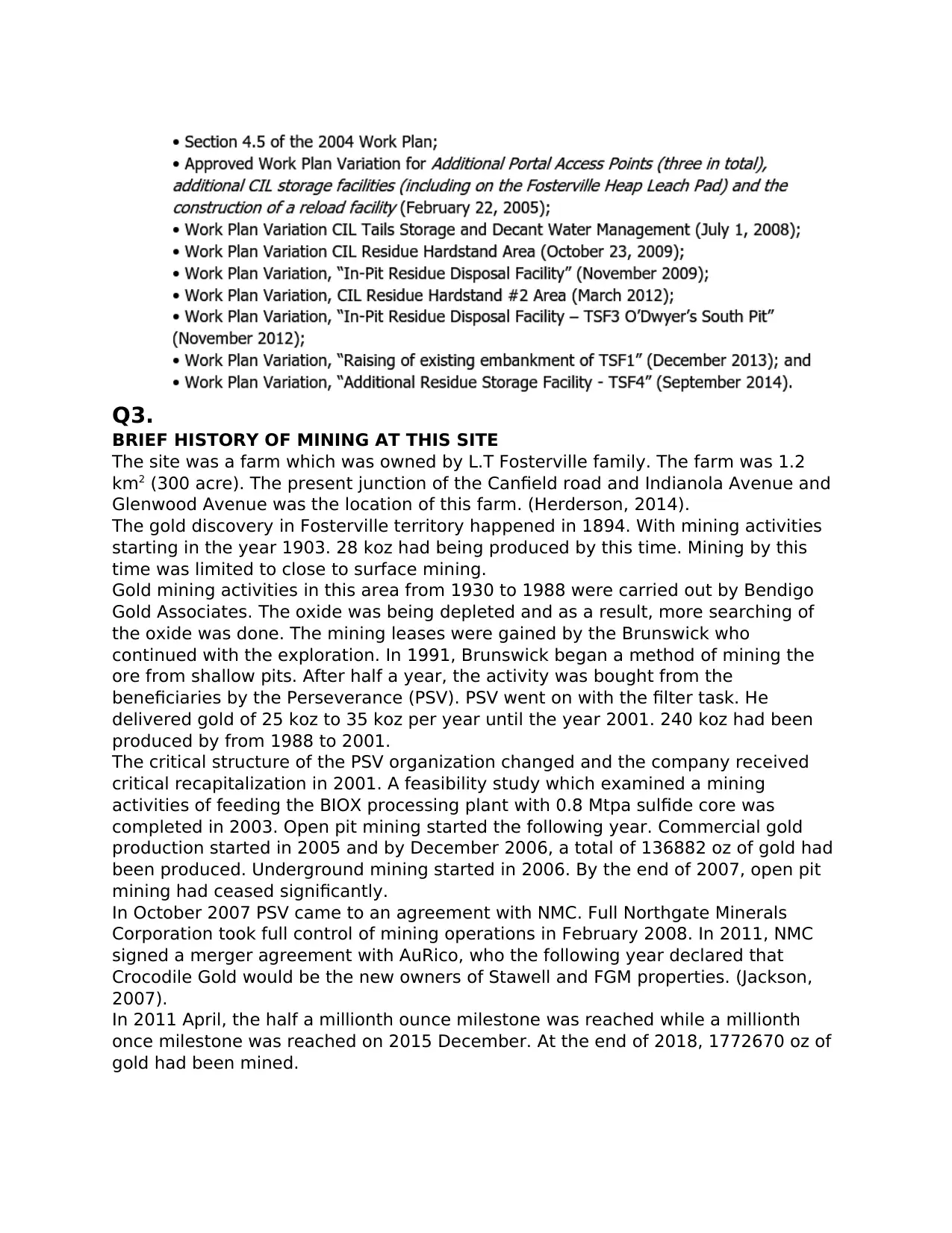
Q3.
BRIEF HISTORY OF MINING AT THIS SITE
The site was a farm which was owned by L.T Fosterville family. The farm was 1.2
km2 (300 acre). The present junction of the Canfield road and Indianola Avenue and
Glenwood Avenue was the location of this farm. (Herderson, 2014).
The gold discovery in Fosterville territory happened in 1894. With mining activities
starting in the year 1903. 28 koz had being produced by this time. Mining by this
time was limited to close to surface mining.
Gold mining activities in this area from 1930 to 1988 were carried out by Bendigo
Gold Associates. The oxide was being depleted and as a result, more searching of
the oxide was done. The mining leases were gained by the Brunswick who
continued with the exploration. In 1991, Brunswick began a method of mining the
ore from shallow pits. After half a year, the activity was bought from the
beneficiaries by the Perseverance (PSV). PSV went on with the filter task. He
delivered gold of 25 koz to 35 koz per year until the year 2001. 240 koz had been
produced by from 1988 to 2001.
The critical structure of the PSV organization changed and the company received
critical recapitalization in 2001. A feasibility study which examined a mining
activities of feeding the BIOX processing plant with 0.8 Mtpa sulfide core was
completed in 2003. Open pit mining started the following year. Commercial gold
production started in 2005 and by December 2006, a total of 136882 oz of gold had
been produced. Underground mining started in 2006. By the end of 2007, open pit
mining had ceased significantly.
In October 2007 PSV came to an agreement with NMC. Full Northgate Minerals
Corporation took full control of mining operations in February 2008. In 2011, NMC
signed a merger agreement with AuRico, who the following year declared that
Crocodile Gold would be the new owners of Stawell and FGM properties. (Jackson,
2007).
In 2011 April, the half a millionth ounce milestone was reached while a millionth
once milestone was reached on 2015 December. At the end of 2018, 1772670 oz of
gold had been mined.
BRIEF HISTORY OF MINING AT THIS SITE
The site was a farm which was owned by L.T Fosterville family. The farm was 1.2
km2 (300 acre). The present junction of the Canfield road and Indianola Avenue and
Glenwood Avenue was the location of this farm. (Herderson, 2014).
The gold discovery in Fosterville territory happened in 1894. With mining activities
starting in the year 1903. 28 koz had being produced by this time. Mining by this
time was limited to close to surface mining.
Gold mining activities in this area from 1930 to 1988 were carried out by Bendigo
Gold Associates. The oxide was being depleted and as a result, more searching of
the oxide was done. The mining leases were gained by the Brunswick who
continued with the exploration. In 1991, Brunswick began a method of mining the
ore from shallow pits. After half a year, the activity was bought from the
beneficiaries by the Perseverance (PSV). PSV went on with the filter task. He
delivered gold of 25 koz to 35 koz per year until the year 2001. 240 koz had been
produced by from 1988 to 2001.
The critical structure of the PSV organization changed and the company received
critical recapitalization in 2001. A feasibility study which examined a mining
activities of feeding the BIOX processing plant with 0.8 Mtpa sulfide core was
completed in 2003. Open pit mining started the following year. Commercial gold
production started in 2005 and by December 2006, a total of 136882 oz of gold had
been produced. Underground mining started in 2006. By the end of 2007, open pit
mining had ceased significantly.
In October 2007 PSV came to an agreement with NMC. Full Northgate Minerals
Corporation took full control of mining operations in February 2008. In 2011, NMC
signed a merger agreement with AuRico, who the following year declared that
Crocodile Gold would be the new owners of Stawell and FGM properties. (Jackson,
2007).
In 2011 April, the half a millionth ounce milestone was reached while a millionth
once milestone was reached on 2015 December. At the end of 2018, 1772670 oz of
gold had been mined.
Paraphrase This Document
Need a fresh take? Get an instant paraphrase of this document with our AI Paraphraser
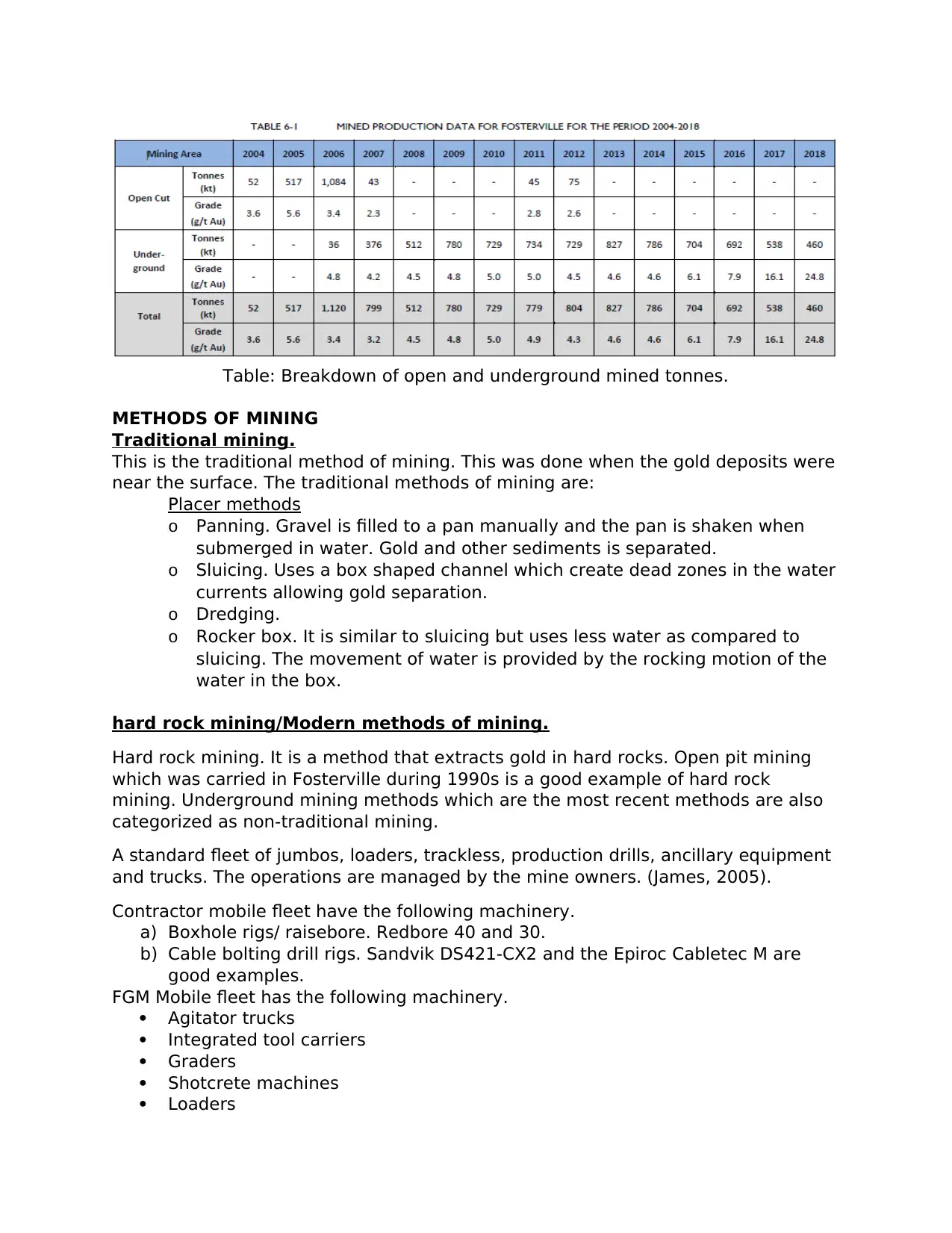
Table: Breakdown of open and underground mined tonnes.
METHODS OF MINING
Traditional mining.
This is the traditional method of mining. This was done when the gold deposits were
near the surface. The traditional methods of mining are:
Placer methods
o Panning. Gravel is filled to a pan manually and the pan is shaken when
submerged in water. Gold and other sediments is separated.
o Sluicing. Uses a box shaped channel which create dead zones in the water
currents allowing gold separation.
o Dredging.
o Rocker box. It is similar to sluicing but uses less water as compared to
sluicing. The movement of water is provided by the rocking motion of the
water in the box.
hard rock mining/Modern methods of mining.
Hard rock mining. It is a method that extracts gold in hard rocks. Open pit mining
which was carried in Fosterville during 1990s is a good example of hard rock
mining. Underground mining methods which are the most recent methods are also
categorized as non-traditional mining.
A standard fleet of jumbos, loaders, trackless, production drills, ancillary equipment
and trucks. The operations are managed by the mine owners. (James, 2005).
Contractor mobile fleet have the following machinery.
a) Boxhole rigs/ raisebore. Redbore 40 and 30.
b) Cable bolting drill rigs. Sandvik DS421-CX2 and the Epiroc Cabletec M are
good examples.
FGM Mobile fleet has the following machinery.
Agitator trucks
Integrated tool carriers
Graders
Shotcrete machines
Loaders
METHODS OF MINING
Traditional mining.
This is the traditional method of mining. This was done when the gold deposits were
near the surface. The traditional methods of mining are:
Placer methods
o Panning. Gravel is filled to a pan manually and the pan is shaken when
submerged in water. Gold and other sediments is separated.
o Sluicing. Uses a box shaped channel which create dead zones in the water
currents allowing gold separation.
o Dredging.
o Rocker box. It is similar to sluicing but uses less water as compared to
sluicing. The movement of water is provided by the rocking motion of the
water in the box.
hard rock mining/Modern methods of mining.
Hard rock mining. It is a method that extracts gold in hard rocks. Open pit mining
which was carried in Fosterville during 1990s is a good example of hard rock
mining. Underground mining methods which are the most recent methods are also
categorized as non-traditional mining.
A standard fleet of jumbos, loaders, trackless, production drills, ancillary equipment
and trucks. The operations are managed by the mine owners. (James, 2005).
Contractor mobile fleet have the following machinery.
a) Boxhole rigs/ raisebore. Redbore 40 and 30.
b) Cable bolting drill rigs. Sandvik DS421-CX2 and the Epiroc Cabletec M are
good examples.
FGM Mobile fleet has the following machinery.
Agitator trucks
Integrated tool carriers
Graders
Shotcrete machines
Loaders
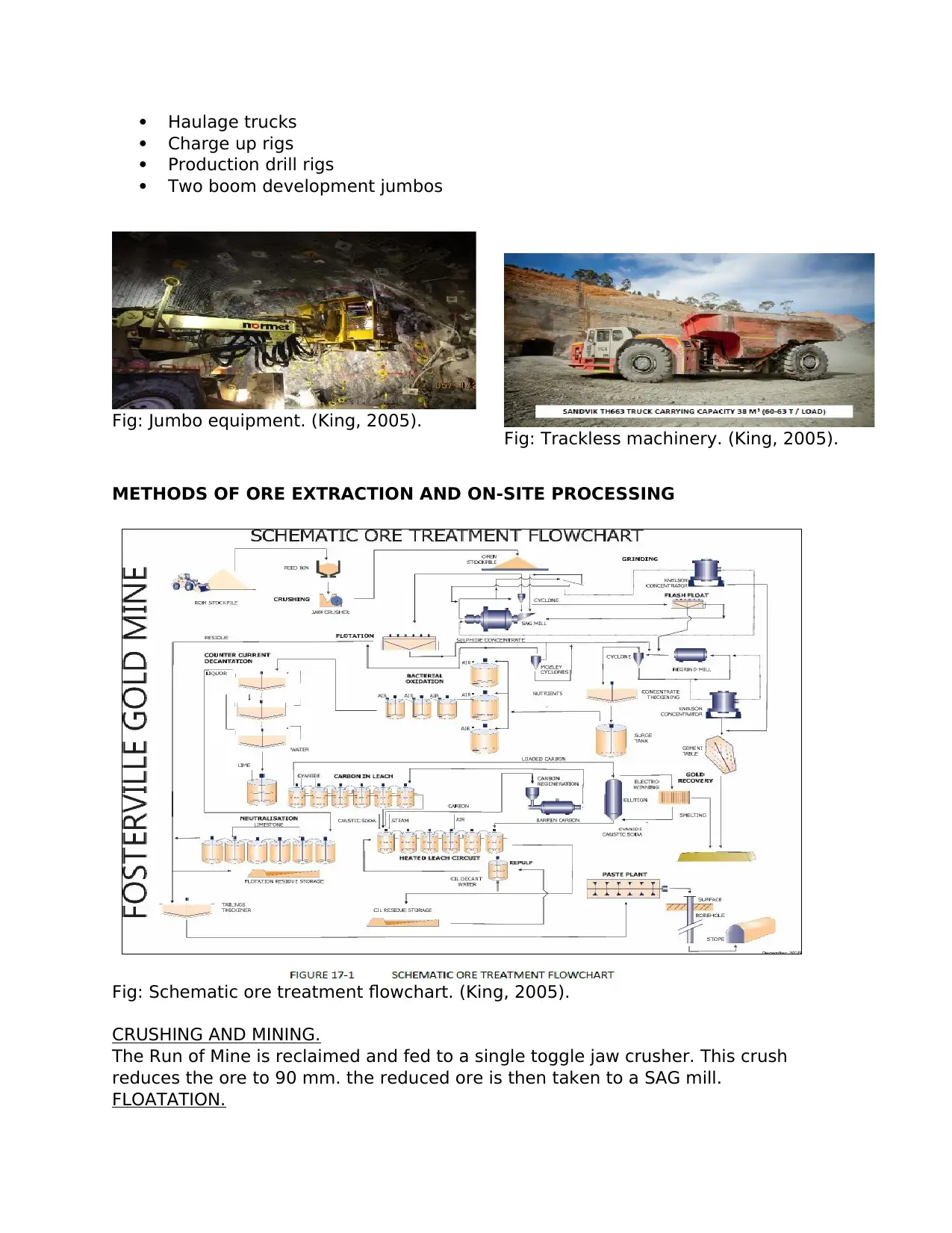
Haulage trucks
Charge up rigs
Production drill rigs
Two boom development jumbos
Fig: Jumbo equipment. (King, 2005).
Fig: Trackless machinery. (King, 2005).
METHODS OF ORE EXTRACTION AND ON-SITE PROCESSING
Fig: Schematic ore treatment flowchart. (King, 2005).
CRUSHING AND MINING.
The Run of Mine is reclaimed and fed to a single toggle jaw crusher. This crush
reduces the ore to 90 mm. the reduced ore is then taken to a SAG mill.
FLOATATION.
Charge up rigs
Production drill rigs
Two boom development jumbos
Fig: Jumbo equipment. (King, 2005).
Fig: Trackless machinery. (King, 2005).
METHODS OF ORE EXTRACTION AND ON-SITE PROCESSING
Fig: Schematic ore treatment flowchart. (King, 2005).
CRUSHING AND MINING.
The Run of Mine is reclaimed and fed to a single toggle jaw crusher. This crush
reduces the ore to 90 mm. the reduced ore is then taken to a SAG mill.
FLOATATION.
⊘ This is a preview!⊘
Do you want full access?
Subscribe today to unlock all pages.

Trusted by 1+ million students worldwide
1 out of 18
Your All-in-One AI-Powered Toolkit for Academic Success.
+13062052269
info@desklib.com
Available 24*7 on WhatsApp / Email
![[object Object]](/_next/static/media/star-bottom.7253800d.svg)
Unlock your academic potential
Copyright © 2020–2025 A2Z Services. All Rights Reserved. Developed and managed by ZUCOL.